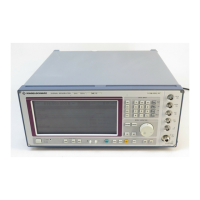Common Commands SME
1038.6002.02 3.16 E-13
*PRE 0 to 255
PARALLEL POLL REGISTER ENABLE sets the parallel poll enable register to the value
indicated. Query *PRE? returns the contents of the parallel poll enable register in decimal form.
*PSC 0 | 1
POWER ON STATUS CLEAR determines whether the contents of the ENABle registers is
maintained or reset in switching on.
*PSC = 0 causes the contents of the status registers to be maintained. Thus a service request
can be triggered in switching on in the case of a corresponding configuration of
status registers ESE and SRE.
*PSC
≠
0 resets the registers.
Query *PSC? reads out the contents of the power-on-status-clear flag. The response can be 0 or 1.
*RCL 0 to 50
RECALL calls the instrument state which was stored under the number supplied using command
*SAV. 50 instrument states can be stored.
*RST
RESET sets the instrument to a defined default status. The command essentially corresponds to
pressing the [PRESET] key. The state of the RF-output is an exception: The RF-output is
deactivated after *RST, however, it is activated after the [RESET] key has been pressed. The
default setting is indicated in the description of the commands.
*SAV 1 to 50
SAVE stores the current instrument state under the number indicated (cf. *RCL as well).
*SRE 0 to 255
SERVICE REQUEST ENABLE sets the service request enable register to the value indicated. Bit
6 (MSS mask bit) remains 0. This command determines under which conditions a service request
is triggered. Query *SRE? reads the contents of the service request enable register in decimal
form. Bit 6 is always 0.
*STB?
READ STATUS BYTE QUERY reads out the contents of the status byte in decimal form.
*TRG
TRIGGER triggers all actions waiting for a trigger event. Special trigger events can be started by
command system "TRIGger" (see section "TRIGger System").
*TST?
SELF TEST QUERY triggers all selftests of the instrument indicated in Chapter 4, Section
"Functional Test" and outputs an error code in decimal form.
*WAI
WAIT-to-CONTINUE only permits the servicing of the subsequent commands after all preceding
commands have been executed and all signals have settled (cf. Section 3.7 and "*OPC" as well).

